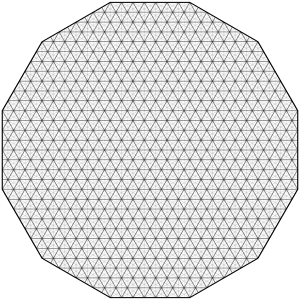Eternity puzzle facts for kids
The Eternity puzzle is a special tiling puzzle that was created by Christopher Monckton. It was first released in June 1999 by the Ertl Company. This puzzle was advertised as being almost impossible to solve. There was a huge prize of £1 million for anyone who could solve it within four years!
The prize was eventually paid out in October 2000. Two clever mathematicians from Cambridge found a winning solution. Later, in 2007, a new prize puzzle called Eternity II was launched.
Contents
What is the Eternity Puzzle?
The goal of the Eternity puzzle is to fill a large, 12-sided board with 209 unique puzzle pieces. The board has a special grid made of small triangles. Imagine a shape with 12 sides, where some sides are a bit longer than others.
Each puzzle piece is made up of 12 tiny triangles. These pieces are called "dodecadrafters." Each piece covers the same area as 6 small equilateral triangles. The entire board is big enough to hold all 209 pieces perfectly.
A hint piece was always shown on the puzzle board and solution sheets. However, players did not have to use it in their final solution to win the prize. You could also get five other hints by solving three smaller puzzles that were sold separately.
How Popular Was It?
When the puzzle came out in June 1999, it was aimed at people who loved puzzles. About 500,000 copies were sold all over the world! The game became very popular for a while. In the month it was launched, Eternity was the best-selling puzzle or game in the UK for its price of £35.
Solving the Puzzle
Right after the puzzle was released, many people started an online group to work on solving it. They shared ideas and tips. People quickly realized that it was easy to fill most of the board. The real challenge was filling the last few empty spaces with the remaining pieces. Often, the pieces left over were the "wrong shapes" to fit the final gaps.
To solve this, people used computers to find out which pieces were easy or hard to fit together. They then used this information to guide their search programs. This helped them try to save the "good" pieces for the tricky end part of the puzzle.
The puzzle was finally solved on May 15, 2000. This was before the first deadline! Two mathematicians from Cambridge, Alex Selby and Oliver Riordan, found the solution. They used a lot of math to figure out how likely it was for pieces to fit into different areas. Their computer program explored many possible ways to place pieces. It picked the ones most likely to lead to a full solution. They found a complete solution in just seven months using two home computers.
Another solution was found independently by Guenter Stertenbrink. He submitted his solution just six weeks later, on July 1, 2000. No other solutions have been shared publicly since then. Interestingly, neither of the known solutions used the hint pieces in their correct places. Alex Selby said it was actually easier to solve the puzzle without using any fixed hint pieces.
The Prize Money
The puzzle's creator, Christopher Monckton, paid half of the £1 million prize himself. The other half came from insurance companies in London. According to the rules, solutions were accepted by mail on September 21, 2000. If no one solved it, entries would be kept for the next year, and so on, until 2003. After that, no more entries would be accepted.
Before selling the puzzle, Monckton thought it would take at least three years to solve. One guess at the time said there were 10500 possible ways to try and solve it. This meant it would take longer than the age of the Universe to check all of them, even with a million computers!
After the puzzle was solved earlier than expected, Monckton claimed he had to sell his large 67-room house, Crimonmogate, to pay the prize. However, in 2006, he admitted this was a PR stunt. He said it was done to boost sales during Christmas. He was going to sell the house anyway, so it had nothing to do with the prize money.
Puzzle's Influence
The design of the Perth Arena in Perth, Western Australia, was greatly inspired by the Eternity puzzle. You can see the puzzle's influence in the building's outside look. It is also reflected inside the main arena, hallways, and meeting rooms.
See also
 In Spanish: Puzzle Eternity para niños
In Spanish: Puzzle Eternity para niños


